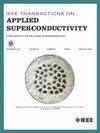An Analytical Methodology to Dimension Self-Supporting Structures in Cos-Theta Superconducting Accelerator Magnets
IF 1.8
3区 物理与天体物理
Q3 ENGINEERING, ELECTRICAL & ELECTRONIC
引用次数: 0
Abstract
Analytical approaches for dimensioning self-supporting structures in cos-theta superconducting magnets are notably scarce in the literature, despite their interest. The dimensions of these structures influence both material costs and the spacing between the coils and the iron yoke, a parameter that can significantly impact the efficiency of the superconductor depending on the design. Therefore, an analytical methodology is proposed here to dimension the self-supporting structures of cos-theta magnets, usually collar-based, by limiting the radial deformation caused by their electromagnetic forces. This approach could enable a more efficient conceptual design phase, as well as the assessment of existing simulation models. The main goal of this article is to present the core concepts of this methodology and apply them to some examples to evaluate its potential. First, the dimensioning of a standalone dipole serves as a case guide, and then the methodology is tested on the well-known design of the Tevatron. Finally, it is applied to the particularly difficult case that sparked its development: the MCBXF orbit correctors required for the high luminosity large hadron collider (HL-LHC) upgrade. In these magnets, the nested configuration implies a challenging coupling between magnetic and mechanical designs, and the simulation results provide a valuable basis for comparison with the analytical calculations.Cos-Theta超导加速器磁体自支撑结构尺寸的分析方法
尽管对cos- θ超导磁体中自支撑结构的分析方法很感兴趣,但在文献中却非常缺乏。这些结构的尺寸既会影响材料成本,也会影响线圈和铁轭之间的间距,根据设计,这个参数会对超导体的效率产生重大影响。因此,本文提出了一种分析方法,通过限制由其电磁力引起的径向变形来确定cos-theta磁体(通常基于项圈)自支撑结构的尺寸。这种方法可以使一个更有效的概念设计阶段,以及现有的仿真模型的评估。本文的主要目标是介绍该方法的核心概念,并将其应用到一些示例中,以评估其潜力。首先,以独立偶极子的尺寸作为案例指导,然后在著名的Tevatron设计上对该方法进行了测试。最后,将其应用于引发其发展的特别困难的情况:高亮度大型强子对撞机(HL-LHC)升级所需的MCBXF轨道校正器。在这些磁体中,嵌套结构意味着磁性和机械设计之间具有挑战性的耦合,仿真结果为与解析计算的比较提供了有价值的基础。
本文章由计算机程序翻译,如有差异,请以英文原文为准。
求助全文
约1分钟内获得全文
求助全文
来源期刊

IEEE Transactions on Applied Superconductivity
工程技术-工程:电子与电气
CiteScore
3.50
自引率
33.30%
发文量
650
审稿时长
2.3 months
期刊介绍:
IEEE Transactions on Applied Superconductivity (TAS) contains articles on the applications of superconductivity and other relevant technology. Electronic applications include analog and digital circuits employing thin films and active devices such as Josephson junctions. Large scale applications include magnets for power applications such as motors and generators, for magnetic resonance, for accelerators, and cable applications such as power transmission.
 求助内容:
求助内容: 应助结果提醒方式:
应助结果提醒方式:


